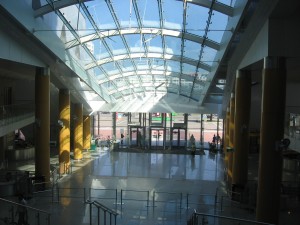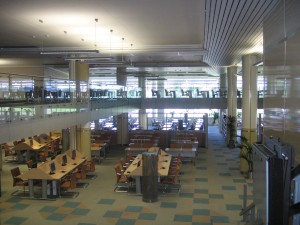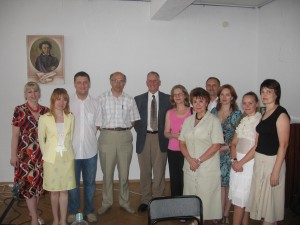On Tuesday, June 30, there were two presentations. The first was at the National Library of the Republic of Belarus on ?Library Assessment in the US: Methods and Tools,? and the audience was the staff of the National Library. The National Library was founded on September 15, 1922, originally as the Belarusian State and University Library. It is the legal deposit library for all publications issued in the USSR and Belarus.
It is a new building, shaped like a diamond, completed in 2005. There are pictures at the English website, http://www.nlb.by/portal/page/portal/index?lang=en
It is a radical design for a building, and even more unusual for a library. The diamond is perched on a point, and its light displays can be seen for miles at night. The book depository is not in the basement, as is typical of many large Russian and former Soviet Union libraries. It is on the fifth floor. Although I didn?t see it, there is even compact shelving.
The inside of the library is even more spectacular, with hundreds of computers, four exhibition areas for art, a open, impressive, entrance lobby, a circulation desk that makes one want to go up to it just to be seen in the vicinity of such a design, and a metal and glass architecture, necessitated by the diamond shape, which is also beautiful. There are many curves inside the library, usually not a good design for square books, but it all seems to work. A librarian gave an excellent presentation of the many online Russian and English databases and digital information resources available to the over 100,000 patrons of the library.
The book delivery system, sending the books from the shelves to the numerous (15?) readings rooms is a marvel. The books are placed in a container on wheels and then whisked away on tracks to the reading rooms on other floors. The book carts are returned empty and upside-down on another track. It is a very efficient system, apparently made in Germany.
In the afternoon, the second presentation was on ?Association of Research Libraries (ARL): activity, mission, goals, and results,? at the Minsk Regional Public Library, named after A Pushkin. Since I am not an employee of ARL, I relied on slides provided by Martha Kyrillidou of ARL for the presentation. The audience was the Belarusian Library Association Council. The BLA was founded in 1992, and it seeks to help in the development of the library systems in Belarus and to help solve problems common to Belarusian libraries, among other goals. The purpose of the presentation, I think, was to learn about ARL to see if any of its initiatives and areas of responsibilities are suitable for the BLA. There are approximately 9,500 libraries in Belarus, and the BLA has approximately 1200 individual members from different types of libraries.
The Minsk Regional Public Library named after A Pushkin is one of 12 libraries in Belarus with American Corners. ??American Corners are partnerships between the Public Affairs sections of U.S. Embassies and host institutions. They provide access to current and reliable information about the U.S. via book collections, the Internet, and through local programming to the general public. ?Unfortunately with the departure of American embassy staff, the American Corners program in Belarus has stopped. ? This American Corner is still functioning, but is frozen in time, with no new materials added.



